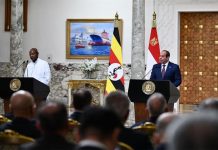Africa-Press – Uganda. The media has done a great job documenting the incidents of ambushes of long-distance trucks along then Nimule-Juba road in South Sudan and the resultant demonstrations and strikes by drivers demanding protection of the government troops.
Similarly, the media has done an equally good, if not better job covering the bijyambiya (machete) killings in the Greater Masaka region and now the sporadic attacks in other neighbouring districts including Rakai and Wakiso.
By the media shining a torch on these violent crimes, the authorities have been forced to come out and explain their lapses as well as be seen to be doing something to restore the situation. In the case of the Juba route ambushes, armed escorts have been offered to the truckers now moving in a convoy. This has reduced the number of attacks and made it safer to transport goods to the war-torn East African country.
In the case of the Masaka killings, no less a person than the minister of State for Internal Affairs has had to camp for a few days in the region to oversee operations to track the criminals and restore confidence in the public that the State is capable of protecting them, even when another attack is reported the next day.
Reporting violent crime unfortunately often degenerates into a routine so that journalists keeps reporting numbers and repeating the same background. The readers and viewers, especially those not directly touched by the violence, soon start to switch channels or turn to the next page after reading the headline screaming “death toll no 20”, etc!
So beyond pilling the statistics, what else can journalists do in circumstances such as these?
Well, this was the subject of my conversation with one of the NMG-Uganda reporters recently. He has been covering the South Sudan truckers’ story and was wondering what other story was there to tell beyond adding up the number of ambushes.
It is also the subject Jonathan Stray focused on in his article; “Beyond the crime scene: We need new and better models for crime reporting” – (Nieman Lab).
So looking at our coverage of the Masaka killings and the Juba road ambushes, what else can our journalists do beyond the good job of documenting incidents already done?
“The classic crime beat, dating from at least the mid-19th century, is evolving. It has to evolve. There are good reasons to believe that the routines of “traditional” crime coverage produce a journalism that just isn’t as good as it needs to be. We need to try something new, writes Mr Stray.
The question is how? Explanatory reporting? Well, even the Police cannot explain? Investigative reporting? Again even the Police is not telling us what its investigations reveal! Yet the public reading about the numbers from the media and not hearing coherent explanations from the Police is filled with many questions.
One way, he argues, is “…the extensive use of data, new story forms, and — in the most drastic departure from the traditional routine — deciding not to visit the crime scene.”
In my conversation with the reporter, I asked if he had plotted out where each ambush has happened and the time of ambush and if so, what pattern emerged. Plotting a pattern goes a long way in explaining crime.
I would say the same to the journalists covering the Masaka killings. To their credit, they already pointed out a clear pattern of the victims; they were mostly the elderly either living alone or living with young children.
It therefore helps the public get better perspective more therefore and keep interest in the crime stories if journalists go beyond the crime scene and step back to try and plot any other emerging patterns.
*****
Readers have your say
Kenneth Agutamba: On behalf of the bank, I would like to express our utmost displeasure at Daily Monitor’s distortive reporting and apparent corporate malice that is carried in the article, “Stanbic Bank hit by banking agents fraud,” (Daily Monitor, Sept 2), whose “intro” deliberately ignores the clear facts stated in a press statement that we proactively distributed to you, in line with our well known effort to always be transparent.






